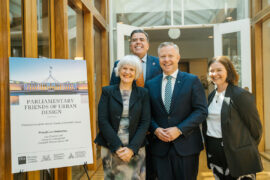Archie Moore’s kith and kin unveiled in the Australia Pavilion at the 60th International Art Exhibition of La Biennale di Venezia.

April 22nd, 2024
Created in-situ over a two-month period, kith and kin by Indigenous artist Archie Moore (Kamilaroi, Bigambul, British and Scottish heritage) comprises a meticulously researched, hand-drawn genealogical chart mapping 2,400 generations of the artist’s ancestry across 65,000 years alongside a display of 500 document stacks that sit atop a reflective pool in the centre of the pavilion.
Curated by Ellie Buttrose and commissioned by Creative Australia, with Kaurareg-Meriam architect Kevin O’Brien as exhibition design consultant, the rigorously researched and thoughtfully executed installation brings an international awareness to First Nations kinship, colonial history, incarceration and deaths in custody. Moore states: “kith and kin is a memorial dedicated to every living thing that has ever lived, it is a space for quiet reflection on the past, the present and the future.” Buttrose, in her catalogue essay posits, “A monumental call to action.”

Hand-drawn in fragile white chalk, set against “blackboard” walls, echoing school education systems, the genealogical chart spans the pavilion’s 5 metre walls which run 60 metres in length, culminating in a point of origin in the centre of the ceiling. Commencing with the artist as “me”, the astonishingly vast map envelopes the interior space, where names of people within boxes linked by fluid lines are both legible and abstract marks that ascend into a celestial, ethereal abyss. Buttrose states: “There is a tension between representation and abstraction. There are gaps in the vast family tree; absences of names signal the severing of family ties from massacres and disease.” The chart is also a vivid representation of the decline in Indigenous languages under colonisation, whilst affirming First Nations Australians’ status as the longest-continuous living culture in the world.
At the centre of the pavilion, the dark reflective pool evokes the atmosphere of a memorial. Suspended above are 500 document stacks (typed on white paper with black redactions) which reveal coronial inquests into deaths of Indigenous people in police custody, and harrowingly, dated in our lifetime.
Related: An exhibition with vision and meaning in Thailand

The Australia Pavilion was originally designed by Phillip Cox in 1988 and more recently redesigned by Denton Corker Marshall in 2015. It is commonly known now as a white box within a black box, sitting adjacent to a serene canal. Of the space, O’Brien posits, “The beauty of the pavilion is that it allows the art to come forward. There is a comfortable accommodation of an exhibition that is effectively uncomfortable in content.” Buttrose states, “kith and kin is immersive, audiences move their bodies to experience it. Stretching their necks to see the ancestral names on the ceiling… The archival documents have been designed to hover at a low height so that people reverently bow when viewing. The central black pool reflects names on the walls, but viewers also catch glimpses of themselves surrounded by the family tree.”
With Moore and Buttrose, O’Brien undertook three key moves to achieve the desired experience of the installation: “Firstly, to compress the natural light by reducing the window opening to the canal. Secondly, to subtly detail the supporting furniture (table and benches) to ensure the art came forward. And thirdly, the use of a reflection pool to give a sense of the topography of official documents above on the table floating – just out of reach.” The effect is “a calm but undeniable sense of monumentality,” notes O’Brien. Buttrose adds, “One of the strengths of the artwork is its clarity of expression.”

Buttrose concludes, “kith and kin conveys the vast scale of time and relational complexity of First Nations Australian kinship, and what impacts these connections. If we trace our lineage back more than four thousand years everyone on Earth shares a common ancestor (known as the genetic isopoint) and how we have a familial responsibility to everyone in the world.” Through revealing personal, political, and historical narratives, Moore highlights our shared ancestry and humanity: through the interconnectedness of people, place and time. Yet kith and kin offers hope of a better future for humanity through understanding and unity.
Archie Moore
kithandkin.me
La Biennale di Venezia
labiennale.org
Photography
Andrea Rossett





Next up: Unleash your creative genius with The Project at Saturday Indesign 2024
INDESIGN is on instagram
Follow @indesignlive
A searchable and comprehensive guide for specifying leading products and their suppliers
Keep up to date with the latest and greatest from our industry BFF's!

Rising above the new Sydney Metro Gadigal Station on Pitt Street, Investa’s Parkline Place is redefining the office property aesthetic.

Merging two hotel identities in one landmark development, Hotel Indigo and Holiday Inn Little Collins capture the spirit of Melbourne through Buchan’s narrative-driven design – elevated by GROHE’s signature craftsmanship.

London-based design duo Raw Edges have joined forces with Established & Sons and Tongue & Groove to introduce Wall to Wall – a hand-stained, “living collection” that transforms parquet flooring into a canvas of colour, pattern, and possibility.

In this comment piece, COX Principal David Holm reflects on Carlo Ratti’s curatorship in which climate, colonisation and gender equity took centre stage at the Venice Biennale.

Developed by an all-First Nations curatorial and creative team, the Australia Pavilion at the Venice Architecture Biennale has officially opened.
The internet never sleeps! Here's the stuff you might have missed

COX Architecture uses saturated colour and hotel-style amenity across the historic St Peters location, designed for Coronation Property.

The Parliamentary Friends reconvened at Parliament House, uniting political and professional leaders to champion architecture and design.